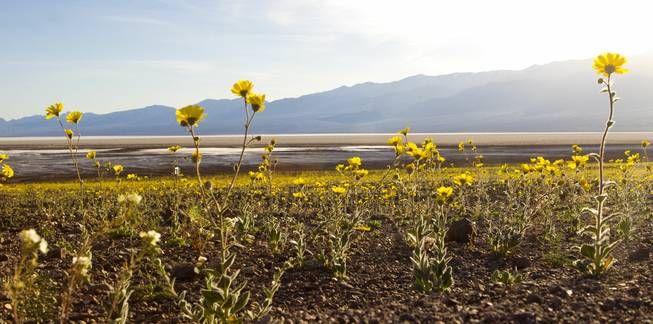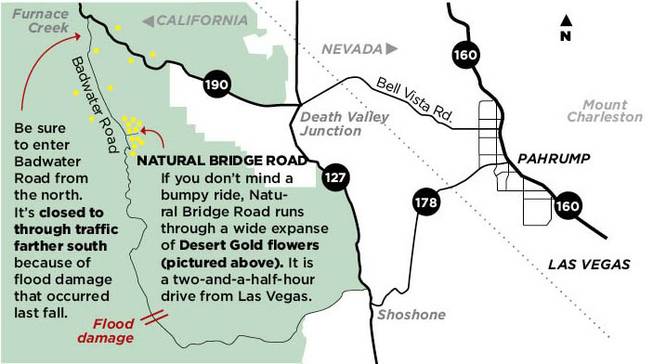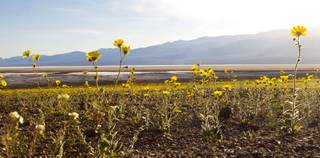
Wildflowers sprout along Badwater Road in Death Valley National Park.
Monday, Feb. 29, 2016 | 2 a.m.
Another bloom in the Southwest
Flowers and Joshua trees are blooming in the northwest corner of California’s Joshua Tree National Park. Visit nps.gov/jotr/planyourvisit/blooms.htm for more information.
DID YOU KNOW?
Death Valley is the eighth-lowest place on Earth, with some areas clocking in at 282 feet below sea level. Unlike other low spots, the park’s depth is caused by fault shifts rather than river erosion.
Death Valley National Park’s arid land and unbearably high temperatures normally make it difficult for plants and wildlife to flourish. But once a decade, the hottest place on Earth surprises us with a rare super bloom, brought on by a perfect mix of weather conditions and seeds that have been lying dormant.
El Niño weather patterns and heavy October rainfall nourished the soil just enough to invite millions of seedlings to the surface en masse for the first time since 2005.
If weather permits, the bloom could last through March. But dry, hot air can cause the flowers to wither to seeds in just a matter of days, so pack some water and your camera, and plan a day trip west.
What causes a super bloom?
Seeds sit dormant, waiting years for enough rain — a half-inch or more at once — to wash off their protective coating and stimulate growth. This time, that heavy rain took place in October. Then, during the fall and winter months, sufficient warmth from the sun, evenly spaced rain showers and a lack of dry wind created super bloom conditions.
What kinds of flowers will I see?
There are dozens of varieties visible throughout the park. Here are just a few in bloom right now:
• Desert Five Spot: This flower opens midday and closes in late afternoon, so be sure to plan accordingly if you have your sights set on this species.
• Purple Mat: Keep your eyes low to the ground. This plant is short, but its petals are vibrant.
• Brown-eyed Evening Primrose: Look closely at this variety. One specific bee species is known to mate amongst its petals.
• Mohavea: Also known as the golden desert snapdragon, this plant has hairy leaves.
• Caltha-leaved Phacelia: Be careful when handling this bloom; secretions from its heart-shaped leaves and stem can cause a poison ivy-like rash.
• Gravel Ghost Flower: This plant thrives in gravel, hence its name, and can grow up to 3 feet tall.
If you go
Wildflowers are abundant throughout Death Valley National Park with hotspots along Badwater Road, off Highway 190, near the entrance of Natural Bridge Road.

• When to go: Now. The super bloom can last through March if weather permits, but the flowers are delicate, and a lack of rain or sudden high temperatures can cause them to go to seed early.
• What else is there to see? A lot. Death Valley is home to spectacular rock formations and the darkest skies available to stargazers in the lower 48. Other key destinations within the park include Badwater, Dante’s View, Ubehebe Crater, Mesquite Flat Sand Dunes and the Racetrack.
• Tips: Before you make the drive, visit nps.gov/deva/learn/nature/wildflower-update-2016.htm. The site offers information about where specifically to go in the park for optimal viewing since flower growth and weather fluctuate. Also, bring plenty of water and sunscreen, and be prepared for spotty cellphone service.


Join the Discussion:
Check this out for a full explanation of our conversion to the LiveFyre commenting system and instructions on how to sign up for an account.
Full comments policy